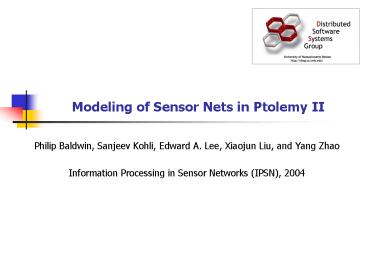Modeling of Sensor Nets in Ptolemy II - PowerPoint PPT Presentation
1 / 20
Title:
Modeling of Sensor Nets in Ptolemy II
Description:
In DE, each event has a timestamp, and Ptolemy II to process events in chronological order. ... the metamodel for sensor network as a set of Java classes ... – PowerPoint PPT presentation
Number of Views:128
Avg rating:3.0/5.0
Title: Modeling of Sensor Nets in Ptolemy II
1
Modeling of Sensor Nets in Ptolemy II
- Philip Baldwin, Sanjeev Kohli, Edward A. Lee,
Xiaojun Liu, and Yang Zhao - Information Processing in Sensor Networks (IPSN),
2004
2
Contents
- Introduction Background
- Ptolemy II and VisualSense
- Architecture of VisualSense
- Metamodel provided by Ptolemy II
- Metamodel provided by VisualSense
- Examples of customization
- Example Model
- Conclusion
3
Introduction
- This research describes an application for
modeling sensor networks. - Ptolemy II is a simulator software
- e.g., discrete event model, continuous time
model - Developed by the authors group
- VisualSense
- Employs Ptolemy II to provide a simulator for
wireless sensor networks - Provides visual modeling environment for wireless
sensor networks
4
Discrete-Event model in Ptolemy II
- DE modeling framework in Ptolemy II
- In DE, each event has a timestamp, and Ptolemy II
to process events in chronological order. - Ptolemy II supports block diagrams
5
- DE Example
- Passengers arrive randomly
- Busses arrive at regular intervals, or according
to a Poisson process. - Record passengers waiting time.
Director specifiesthe simulation model
Each element has ports to connect to other
elements
- DE is a common technique for network simulations
- Block diagrams are a poor representation of a
sensor network, because the inter-connection
topology is highly variable
6
- VisualSense
- Reuses Ptolemy II DE model
- Extends the metamodel of Ptolemy II to support
wireless connections. - Removes the need for explicit connections between
components (e.g., sensor nodes), and introduce
wireless channels. - Wireless channels are implicit connections, and
can be determined on the basis of the physical
locations of components - Extensible to support various connections
- e.g., different media (acoustic, optical and
radio), high/low reliability,
7
Example in VisualSense
outsideChannel of radioIn (port) is radio
insideChannel of radioIn is not specified (means
normal ED)
- Wireless
- Wireless Director
- DE model for wireless
- No explicit connectors between components.
- In wireless devices
- DE model
8
Architecture of VisualSense
- VisualSense defines new metamodel elements (e.g.,
wireless channel) extending the metamodel of
Ptolemy II
9
Ptolemy II metamodel
- ComponentEntity, Port and Relation are key
elements in models - Executable components (e.g., sensor nodes)
implements Actor interface - Actor can be TypedAtomicActor or
TypedCompsiteActor - A model is also a TypedCompositeActor
- Director specifies a simulation model
10
VisualSense metamodel
11
- Based on Ptolemy II metamodel, VisualSense
introduces - WirelessChannel and AtomicWirelessChannel
- Represent wireless connections between sensor
nodes - Provides services
- Calculate the distance between nodes and
determine if they are connected (in range or
not). - Transmit data
- Packet lost or delay may happen
- WirelessIOPort
- Represent ports sensor nodes have
- Sensor nodes use this port to transmit data
- WirelessIOPort calls a corresponding
WirelessChannel to transmit data.
12
- Ptolemy II allows developers to define (extends)
its metamodel in Java - It imports the metamodel defined in Java and
tailored its GUI to support modeling using the
metamodel - e.g., new elements, such as sensor nodes, are
provided - Behavior of model elements in simulation is
defined by a Java code - VisualSense defines the metamodel for sensor
network as a set of Java classes
13
- The default behavior of AtomicWirelessChannel
- By calling _receiversInRange() method, it
determines which receivers are in range - By overriding _receiversInRange() in subclasses,
developers can implement any discovery
algorithms. - AtomicWirelessChannel assumes no packet loss, no
delay and infinite range.
14
- VisualSense provides ErasureChannel,
DelayChannel, LimitedRangeChannel and
PowerLossChannel as subclasses of
AtomicWirelessChannel.
15
- Erasure Channel
- Packet loss happens in a Erasure Channel
16
- Limited Range Channel
- Limited Range Channel overrides _isInRange() to
limit the radio range.
17
- transmit() method of WirelessChannel takes
property as one of parameters - Support any types of values
- Ex) PowerLossChannel
- Takes properties
- Path loss constants
- i.e., how soon the signal becomes weak
- Antenna efficiency
- i.e., to calculate transmission power
- The channel calculates the receive power using
the specified parameters, and the receiving node
determine if the signal is powerful enough.
18
Visualization
- Ptolemy II allows developers to add icons for
their metamodels - VisualSense provides some icons
19
Example Packet Routing Simulator
- Simulator
- Evaluate routing algorithm
- Used in another paper
- Base station (antenna with a green circle) sends
packets repeatedly. - Sensor nodes learn the network topology and
constructs routing paths. - After some periods, several nodes stops to route
packets (blue circle), and the rest routes
packets (red circle)
20
Conclusion
- The authors develop a simulator and development
environment for wireless sensor networks. - Simulator ? Ptolemy II
- The authors defines a metamodel for wireless
sensor networks as an extension of the Ptolemy
IIs metamodel - Metamodel for wireless connections
- Ptolemy IIs GUI tailors itself to support the
extended metamodel































